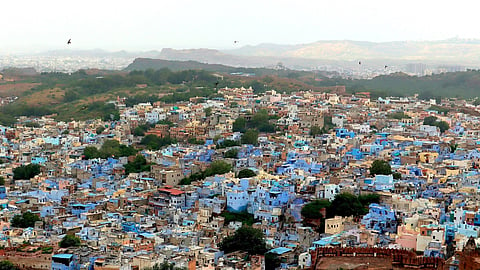The Rajas of Rajputana | Travelogue
It happened at last when Kuldeep Singh proclaimed his affiliation with the royal lineage and this did not surprise us.
When he faces a conversation drought, he instinctively reaches for his phone and makes calls even while driving. The dialect is strikingly unfamiliar. In the web series 'Dahad', ‘taare’ is used instead of ‘tere’ and hukum (order) takes the nuanced role of affirmation.
Kuldeep’s dialect diverged significantly from the Hindi taught in schools or heard in Hindi movies. Finally, when we asked him, he said it was ‘Marwari’.
Kuldeep unfurled his knowledge of history of sorts, elucidating that contemporary Jodhpur is an ancient realm of Marwar, historically governed exclusively by Hindu monarchs.
Mewar (present day Jaipur) stood at the helm of the 26 princely states of the erstwhile Rajputana and its ruler held the prestigious title of Maharana (king of kings) while the others had a maharaja.
The Mehrangarh Fort stands as a true emblem of ancient Marwad. It takes at least half a day to explore the grand fort on foot. The fort, akin to a vast museum, meticulously safeguards antiquity and history. Within, there is a space for artisans and craftsmen. These skilled people rotate from week to week, from traditional painters to gifted shoemakers of Jodhpur. A portion of the proceeds from their trade is channeled into the fort’s conservation.
Nothing is overpriced considering that it is a place where only tourists come. When enquiring about the cost of a pair of Jodhpuri slippers, the trader confidently asserted that their prices were fixed, and the tag only confirmed that it was indeed affordably priced.
From the elevated vantage, one can see a circular structure that resembles a fortified wall. The structure served as the well into which Batman descended in the movie ‘The Dark Knight Rises’. The underground jail scene in the film was also shot inside the fort.
Not far from Mehrangarh stands Jaswant Thada, a monument referred to as the Taj Mahal of Jodhpur. Situated alongside a lake, this splendid marble edifice was built by Sardar Singh in memory of father Jaswant Singh II, the Maharaja of Jodhpur, similar to Shah Jahan building the Taj in memory of his wife Mumtaz. A special type of light-emitting marble has been used for its construction. When the sun shines, the light filtering through the marble material illuminates the wall, creating a captivating visual spectacle.
One side of Jaswant Thada has memorials of the Rathod family. While the grounds feature a serene water fountain and terraced gardens, the most awe-inspiring vista is the commanding presence of the Mehrangarh Fort, visible from the monument's rear. The fort area occupies an expansive 1200 acres and was built in 1459 by Rajput ruler Rao Jodha, who lent his name to the city, and made Jodhpur the capital of Marwar.
Numerous opulent palaces are nestled within the fort, such as Moti Mahal and Phool Mahal, each of which has retained its resplendent allure even after more than five centuries. The fort walls bear handprints of Rajput women who performed Sati. Additionally, the fort boasts of a gate adorned with cannons, monuments commemorating those who were sacrificed during its construction and even a small dargah.
From the fort summit down to the inhabited areas below, one becomes aware why Jodhpur is referred to as the 'Blue City'. The old buildings are predominantly adorned in shades of blue, lending the city its distinctive moniker.
The high azure-hued buildings in the city were once residences of the Brahmin community, who had come down and settled here during the construction of the fort and the palaces within. Legend is that the early buildings were painted blue as a form of protection, as the blue tint acted as a deterrent against insects and helped mitigate the desert’s scorching heat. The choice of colour also carries a caste connotation, as blue is traditionally associated with the Brahmin community!
Though described as a blue city, Jodhpur is a kaleidoscope reflecting various hues of castes.
(To be concluded)
Part 1: Bishnois – the sentinels of nature
Part 2: Turbans mark castes in Jodhpur
Part 3: Harems turn into rental apartments
Part 4: The Rajas of Rajputana
Part 5: Marwar's Festival of Tastes


